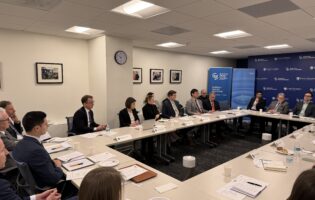Housing beyond Profit: A Comparison of U.S. and German Alternative Ownership Models
On June 22, 2012, the American-German Institute (AGI) hosted an afternoon discussion entitled, “Housing beyond Profit: A Comparison of U.S. and German Alternative Housing Models.” This event featured the research of Ms. Sabine Horlitz, DAAD/AGI visiting fellow. An architect by training and a current doctoral fellow at the Center for Metropolitan Studies in Berlin, Ms. Horlitz drew upon her dynamic knowledge of housing politics as she presented her research. During the discussion, Ms. Horlitz operated under the understanding that neither the market nor the government adequately addresses the housing needs, especially of low-income people, as she explored alternatives to the current dominant forms of the provision of housing.
To begin her presentation, Ms. Horlitz gave an account of the reasons for developing those alternative housing models—relating both to the market and the state. Here, the process of gentrification on the one hand, with its rising house prices and rents that often lead to displacement—a very pressing problem, not only in DC—and of disinvestment and decline, on the other, reinforce housing problems. Moreover, the 2008 financial and real estate crisis, and its millions of foreclosures, as well as the inadequacy of state institutions to act, the continuous sell-out of their municipal housing stock, and the cut-back of rent control have not only made clear that the provision of housing as a for-profit investment contradicts its fundamental task to serve a basic human need, but also that dealing with those problems is not regarded as a prime governmental issue, at least for the time being. Investigating and experimenting with contemporary provisions for low-income housing is thus left to the social and housing movements, together with a few research institutions.
The presentation highlighted three alternative housing models including Limited Equity Coops, Community Land Trusts in the U.S., and the Mietshäusersyndikat or Tenement Trust on the German side. While each of the aforementioned models features different organizational and legal frameworks, they all seek to de-commodify housing by limiting individual profit-making thus working toward their goal of guaranteeing permanent affordability of their housing stock. They ensure tenancy, democratize the provision of housing, and foster community control, as each model incorporates modes of self-governing and resident participation.
Following Ms. Horlitz’s presentation, members of the audience raised topics for debate pertaining to those alternative models of ownership as well as to the similarities and differences of U.S. and German housing politics and the role of state regulation therein. Ms. Horlitz, among other things, pointed to the many distinctions between public housing in the U.S. and social housing as it is called in Germany ranging from the lay-out of the actual buildings to the amount of units built (that in Berlin once amounted to around 25 percent of the entire housing stock), their respective target group, and, importantly, their acceptance by the general public. The discussion then also included land issues and raised the question of how to generally preserve values produced by the public or the community. While it became clear that there are huge cultural differences between both countries regarding the notion of homeownership, that also get translated in how incentives are made and tax moneys are redistributed, it also became clear that those have to be rethought if one wants to more adequately address all people’s needs.







